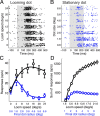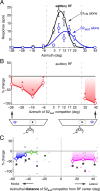Global inhibition and stimulus competition in the owl optic tectum
- PMID: 20130182
- PMCID: PMC2828882
- DOI: 10.1523/JNEUROSCI.3740-09.2010
Global inhibition and stimulus competition in the owl optic tectum
Abstract
Stimulus selection for gaze and spatial attention involves competition among stimuli across sensory modalities and across all of space. We demonstrate that such cross-modal, global competition takes place in the intermediate and deep layers of the optic tectum, a structure known to be involved in gaze control and attention. A variety of either visual or auditory stimuli located anywhere outside of a neuron's receptive field (RF) were shown to suppress or completely eliminate responses to a visual stimulus located inside the RF in nitrous oxide sedated owls. The essential mechanism underlying this stimulus competition is global, divisive inhibition. Unlike the effect of the classical inhibitory surround, which decreases with distance from the RF center and shapes neuronal responses to individual stimuli, global inhibition acts across the entirety of space and modulates responses primarily in the context of multiple stimuli. Whereas the source of this global inhibition is as yet unknown, our data indicate that different networks mediate the classical surround and global inhibition. We hypothesize that this global, cross-modal inhibition, which acts automatically in a bottom-up manner even in sedated animals, is critical to the creation of a map of stimulus salience in the optic tectum.
Figures









Similar articles
-
Signaling of the strongest stimulus in the owl optic tectum.J Neurosci. 2011 Apr 6;31(14):5186-96. doi: 10.1523/JNEUROSCI.4592-10.2011. J Neurosci. 2011. PMID: 21471353 Free PMC article.
-
Stimulus-driven competition in a cholinergic midbrain nucleus.Nat Neurosci. 2010 Jul;13(7):889-95. doi: 10.1038/nn.2573. Epub 2010 Jun 6. Nat Neurosci. 2010. PMID: 20526331 Free PMC article.
-
Hearing impairment induces frequency-specific adjustments in auditory spatial tuning in the optic tectum of young owls.J Neurophysiol. 1999 Nov;82(5):2197-209. doi: 10.1152/jn.1999.82.5.2197. J Neurophysiol. 1999. PMID: 10561399
-
Stimulus-specific adaptation, habituation and change detection in the gaze control system.Biol Cybern. 2012 Dec;106(11-12):657-68. doi: 10.1007/s00422-012-0497-3. Epub 2012 Jun 19. Biol Cybern. 2012. PMID: 22711216 Review.
-
Contribution of feedforward, lateral and feedback connections to the classical receptive field center and extra-classical receptive field surround of primate V1 neurons.Prog Brain Res. 2006;154:93-120. doi: 10.1016/S0079-6123(06)54005-1. Prog Brain Res. 2006. PMID: 17010705 Review.
Cited by
-
Long-range neural inhibition and stimulus competition in the archerfish optic tectum.J Comp Physiol A Neuroethol Sens Neural Behav Physiol. 2019 Aug;205(4):537-552. doi: 10.1007/s00359-019-01345-1. Epub 2019 May 23. J Comp Physiol A Neuroethol Sens Neural Behav Physiol. 2019. PMID: 31123813
-
Recurrent antitopographic inhibition mediates competitive stimulus selection in an attention network.J Neurophysiol. 2011 Feb;105(2):793-805. doi: 10.1152/jn.00673.2010. Epub 2010 Dec 15. J Neurophysiol. 2011. PMID: 21160008 Free PMC article.
-
The role of a midbrain network in competitive stimulus selection.Curr Opin Neurobiol. 2011 Aug;21(4):653-60. doi: 10.1016/j.conb.2011.05.024. Epub 2011 Jun 21. Curr Opin Neurobiol. 2011. PMID: 21696945 Free PMC article. Review.
-
Combinatorial Neural Inhibition for Stimulus Selection across Space.Cell Rep. 2018 Oct 30;25(5):1158-1170.e9. doi: 10.1016/j.celrep.2018.10.022. Cell Rep. 2018. PMID: 30380408 Free PMC article.
-
Rules of competitive stimulus selection in a cholinergic isthmic nucleus of the owl midbrain.J Neurosci. 2011 Apr 20;31(16):6088-97. doi: 10.1523/JNEUROSCI.0023-11.2011. J Neurosci. 2011. PMID: 21508234 Free PMC article.
References
-
- Akaike H. A new look at the statistical model identification. IEEE Trans Automat Contr. 1974;19:716–723.
-
- Alvarado JC, Vaughan JW, Stanford TR, Stein BE. Multisensory versus unisensory integration: contrasting modes in the superior colliculus. J Neurophysiol. 2007;97:3193–3205. - PubMed
-
- Baccus SA. Timing and computation in inner retinal circuitry. Annu Rev Physiol. 2007;69:271–290. - PubMed
-
- Baddeley A. Working memory: looking back and looking forward. Nat Rev Neurosci. 2003;4:829–839. - PubMed
-
- Basso MA, Wurtz RH. Modulation of neuronal activity by target uncertainty. Nature. 1997;389:66–69. - PubMed
Publication types
MeSH terms
Grants and funding
LinkOut - more resources
Full Text Sources
